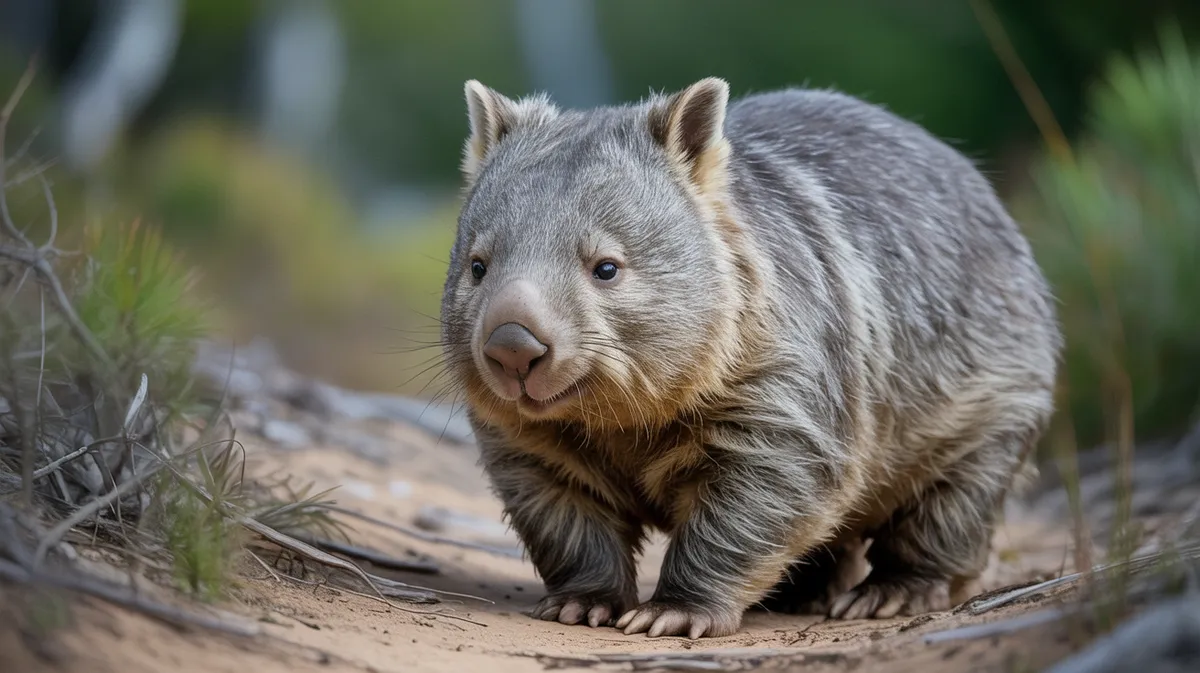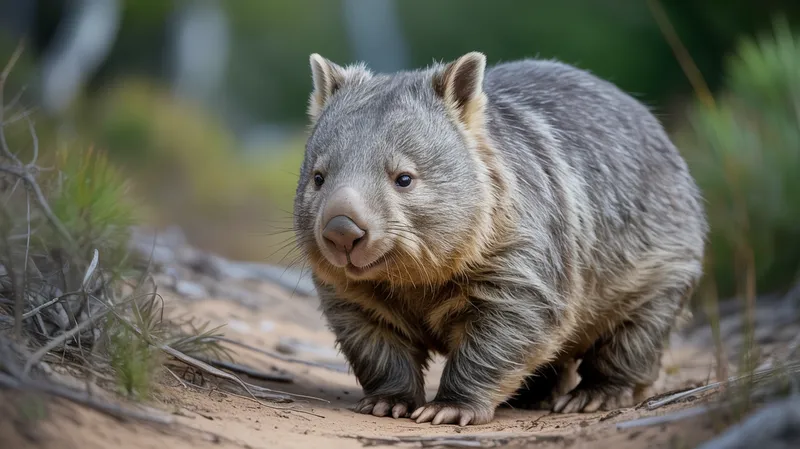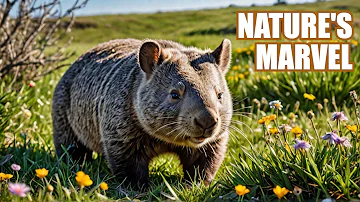
Common Wombat
Vombatus ursinus

Meet the Common Wombat
The Common Wombat is a sturdy, burrowing marsupial native to southeastern Australia, including Tasmania. Distinguished by its short legs, coarse fur, and compact body, it is well adapted for digging extensive burrow systems. Wombats are nocturnal and solitary, emerging at night to graze on grasses, roots, and bark. Despite their slow appearance, they can run surprisingly fast when threatened and use their toughened rear to block burrow entrances from predators.
Classification
Mammal
Habitat
Temperate forests, woodlands, and grasslands
Diet
Herbivore
Lifespan
5-15 years in the wild
Conservation
Least Concern
Weight
20-35 kg
📖Fascinating Facts
Expert Diggers
Common Wombats use their strong claws and powerful limbs to dig elaborate burrow systems that can extend up to 30 meters in length.
Ever-Growing Teeth
Their incisors are similar to those of rodents and grow continuously throughout their lives, enabling them to chew through tough plant material.
Cubed Poop
Wombats produce distinct cube-shaped feces, which help them mark their territory and communicate with other wombats.
📋Detailed Description
The common wombat (Vombatus ursinus) is a robust, medium-sized marsupial weighing between 20 and 35 kg, with adults measuring 80–110 cm in length and standing about 25–35 cm at the shoulder. Its body is compact and muscular, covered in coarse fur that ranges from sandy to dark brown or grey, with a bare, leathery nose distinguishing it from hairy-nosed wombats. The limbs are short and powerful, equipped with strong claws adapted for digging extensive burrow systems that can reach up to 30 meters in length and several meters deep. The skull is broad and flat, housing ever-growing incisors similar to rodents, which are essential for gnawing tough vegetation. Wombats possess a backward-facing pouch, protecting the young from soil while digging. Primarily nocturnal and crepuscular, they spend daylight hours in their burrows to avoid temperature extremes. Solitary by nature, they maintain overlapping home ranges but rarely interact outside of breeding. Their digestive system is highly specialized, with an exceptionally long gut transit time (up to 14 days), allowing efficient extraction of nutrients from fibrous, low-quality forage. Notably, common wombats produce distinctive cube-shaped feces, an adaptation thought to aid in territory marking.
💡 Did you know?
A wombat's teeth never stop growing, allowing them to continuously gnaw tough vegetation without wearing down their teeth.
🔬Research & Sources
Wikipedia Summary
The common wombat, also known as the bare-nosed wombat, is a marsupial, one of three extant species of wombats and the only one in the genus Vombatus. It has three subspecies: Vombatus ursinus hirsutus, found on the Australian mainland; Vombatus ursinus tasmaniensis, found in Tasmania; and Vombatus ursinus ursinus, found on Flinders Island and Maria Island in the Bass Strait.
Last Modified: 6/2/2025
🎭Behavior & Social Structure
Common wombats are predominantly solitary and territorial, marking their home ranges with scent glands and cube-shaped droppings. They are mostly nocturnal, emerging at dusk to forage and returning to their burrows before sunrise. Foraging behavior is methodical, with individuals grazing on grasses, sedges, roots, and occasionally bark or fungi, using their incisors to clip vegetation close to the ground. They can travel up to 3 km in a single night in search of food. Wombats are generally non-aggressive but will defend their burrows vigorously, using their toughened rumps as a shield or to crush intruders against tunnel walls. Social interactions are limited, though burrow sharing may occur in resource-rich areas. Vocalizations are rare but include low grunts, hisses, and alarm calls. Grooming is performed with their incisors and hind feet, and dust bathing is common.
👶Reproduction & Life Cycle
Breeding in common wombats can occur year-round but peaks in spring and early summer, particularly in regions with seasonal rainfall. Females are polyestrous and may breed annually or biennially, depending on resource availability. After a brief courtship involving scent marking and chasing, copulation occurs underground or near burrow entrances. Gestation lasts approximately 20–22 days, after which a single, underdeveloped joey is born and immediately crawls into the backward-facing pouch. The pouch phase lasts about 6–7 months, during which the joey is nourished by milk and remains protected. After leaving the pouch, the young continues to suckle and stays close to the mother for an additional 3–8 months before becoming fully independent. Sexual maturity is reached at 2–3 years. Parental care is provided solely by the mother, with no involvement from the male.
🛡️Adaptations & Survival
The common wombat exhibits several key adaptations for a fossorial lifestyle. Its powerful forelimbs and large claws enable efficient excavation of complex burrow systems, which provide thermal regulation and protection from predators. The backward-facing pouch prevents soil from entering while digging. Their slow metabolism and elongated digestive tract allow them to survive on low-nutrient, fibrous vegetation, extracting maximum moisture and nutrients. The cube-shaped feces are a unique adaptation for territory marking, preventing droppings from rolling away on sloped terrain. Wombats have thick skin and cartilage over their rumps, which serve as both armor and a defensive weapon against predators. Their incisors grow continuously, compensating for constant wear from gnawing tough plant material.
🎨Cultural Significance
Wombats hold a unique place in Australian culture and folklore. They feature in Aboriginal Dreamtime stories as wise and resilient creatures, often symbolizing strength and perseverance. The common wombat is a popular figure in Australian literature and children's media, such as the beloved book 'Diary of a Wombat.' Wombats are sometimes used as mascots for conservation campaigns and local events. While not traditionally hunted for food, their burrowing habits have historically brought them into conflict with farmers, leading to mixed perceptions. Today, they are widely regarded as charismatic native fauna and are protected by law in most regions.
🔬Recent Research & Discoveries
Recent research on common wombats has focused on the biomechanics of their digging behavior, revealing specialized muscle and bone adaptations for fossorial activity. Studies on their unique fecal morphology have provided insights into the elasticity of the colon and the role of water absorption in shaping droppings. Ongoing ecological research is investigating the impacts of sarcoptic mange on population dynamics and the effectiveness of treatment protocols in wild populations. Genetic studies have clarified subspecies boundaries and highlighted the need for targeted conservation on isolated island populations. Long-term monitoring projects are assessing the effects of climate change on habitat use and reproductive success.
🎥Wildlife Videos

Everything You Need To Know About Wombats | Secret Life of the Wombat 101+102
In this series we meet common or bare nosed wombats, living in the woods of South East Australia and Tasmania, and southern ...
Love Nature

Wombats Look Like Real Life Ewoks
----------- This episode was shot earlier this year before the mandatory lock down. ----------- Support Animalogic on Patreon: ...
Animalogic

Wildlife - Just Marsupials | Free Documentary Nature
Wildlife - Episode 8: Just Marsupials | Wildlife Documentary Watch 'Wildlife - Episode 9' here: https://youtu.be/cjTapqwpkfg Furry, ...
Free Documentary - Nature

Wombats: The Secret Life of Australia's Burrowing Marsupials
Dive into the fascinating world of wombats in "Wombats: The Secret Life of Australia's Burrowing Marsupials." This video takes you ...
World Wonders

Wombats and Their Cube Poop: Nature's Underground Engineers!
Wombats and Their Cube Poop: Nature's Underground Engineers! https://youtu.be/qv5lhD8uYC8 What animal poops in perfect ...
Easy Way

Discovering Wombats: Nature's Burrowing Marvels!
Discover the fascinating world of wombats in this in-depth exploration of one of Australia's most intriguing creatures! From their ...
ANI TV
🌍Habitat Information
The Common Wombat typically inhabits Temperate forests, woodlands, and grasslands environments. Common Wombats have adapted to their environments with specialized features and behaviors.
Primary Habitat:
Temperate forests, woodlands, and grasslands
More detailed habitat information will be available soon.
🛡️Conservation Status
The Common Wombat is currently classified as Least Concern. Conservation efforts are crucial for preserving this species for future generations.
Common Threats:
- 🏠Habitat loss and fragmentation
- 🌡️Climate change impacts
- 🎯Hunting and poaching
- 🏭Human-wildlife conflict
⚠️Threats & Conservation Challenges
While classified as Least Concern by the IUCN, common wombat populations face several localized threats. Habitat loss and fragmentation due to agriculture, urbanization, and road construction have reduced suitable foraging and burrowing areas. Road mortality is significant, especially in regions with high vehicle traffic. Sarcoptic mange, caused by the mite Sarcoptes scabiei, is a major disease affecting populations, leading to severe skin lesions, secondary infections, and often death if untreated. Competition with livestock for grazing and persecution as agricultural pests also pose challenges. Climate change, with increased drought frequency, may further impact food availability and water sources. Despite these threats, the species remains widespread and relatively abundant in suitable habitats.
🔬Scientific Classification
Scientific Name
Vombatus ursinus
Classification Hierarchy
🔍 About Taxonomic Classification
Taxonomic classification is a hierarchical system used by scientists to classify and organize living organisms based on shared characteristics and evolutionary relationships.
The system moves from broad categories (Kingdom) to increasingly specific ones, with each animal's scientific name typically consisting of its Genus and species.
📝Community Notes
Share your observations and insights about the Common Wombat with our community of wildlife enthusiasts.
Join Our Community
Sign in to share your observations and connect with fellow wildlife enthusiasts.
Sign In to ContributeNo community notes yet
Be the first to share your observations about the Common Wombat!
Explore Common Wombat
Select a tab above to learn more about this amazing animal.
📸Photo Gallery
No photos available for this animal yet.
🌟Discover More Wildlife
Continue your journey of discovery with more fascinating animals from our database
